#as long as there is communication
Text

I have seen some cisgender people confused who are lesbian, gay, or straight when it comes to dating nonbinary people.
So hi, I'm Louie & I'm a fem nonbinary person! I also have a boyfriend who is straight but I'm gonna help clear up things (hopefully).
☆ミ Disclaimer ☆ミ
Please take my words with a grain of salt because every experience is absolutely different & this is my own personal experience including my own interpretation of it as well. Please don't use this as like full evidence & do ask around people who are also in a similar spot to gain a little more of a idea. I'm not responsible for what you do. Please don't sue me. Thank yewwww :3 - Louie
Being in relationships are complicated. They always will be but you can always make things less complicated by just asking & having a conversation about it with your partner!
My boyfriend, let's call him "N" for the rest of this for convenience, loves me for who I am. However, N does struggle using my preferred pronouns (They/Them) but it doesn't mean he loves me any less. He still tries & that matters because it shows that he cares & respects my identity. This information is also kinda new to N since I told him before we started dating (Which was not long ago). Everyone's experiences is different so I'm just sharing mine to give you a bit of a example.
I was scared of telling him that I was nonbinary because I was really scared of him not loving me but I was wrong because he loved me anyway.
However, this may not be the case for everyone. People tend to be a bit more accepting of someone being of someone's sexuality than someone's gender which sucks. It's also scary as well when you fall in love with someone that potentially harm you with that information especially when you're closeted. So when it comes to telling someone you're apart of the nonbinary spectrum, people make it even more complicated than it should be.
Telling someone you love that you are not a girl or not a boy is hard because of the multiple consequences that come from it & we wish it was just a simple "I understand :]" but it's not.
So I'm gonna tell you what you can do if they don't accept you:
Break up
Which kinda sounds very harsh as hell but it's one of the many truths that you gotta handle. You cannot force someone to accept you because not everyone is going to. You are going have to just move on which is not easy for anyone. You should never change who you are for someone. Relationships should make you feel safe, welcomed, & feel like warm home that you can always come to when needed comfort.
However if your partner refuses to provide you that & neglect your identity that makes you "you"? Then you gonna have to find someone else that will love you for who you are.
Now the cis people in the audience lemme tell you something:
If you are uncomfortable with dating a nonbinary person, that's 100% okay as long you're respectful of their identity.
This doesn't make you a dick. People in the comments are definitely gonna come at me for this but like I said "my opinion my rules" & if you don't like it, find someone else to listen to. No one should force you into a relationship that you're uncomfortable with. Everyone in that relationship should feel like a equal not a slave to a relationship that you're not happy with. However, this is no excuse of you being a asshole.
Be respectful to someone's identity.
"If I accept their identity & continue this relationship with them, does this make me gay/straight?"
It depends how you see it. In my opinion, if ya straight, then you're straight. If ya gay, then ya gay. Dating a nonbinary person doesn't change your sexuality but if it does make you uncomfortable, that's completely up to you. That's how I see it.
"How can I help my nonbinary partner feel comfortable?"
First of all, that's what I like to see & it's always good to assure your partner that you're there for them. Second of all, you can always ask your partner what's wrong & if you're not sure what to ask, some nice neutral questions would be:
"What can I do help you?"
"How can I help you?"
Otherwise, do what you can to help your partner. That being asking other nonbinary people about their experiences or just using the information found on the internet. However, take everything with a grain of salt.
In conclusion:
Please make nonbinary people feel accepted without being a dickhead. Make sure they have space to make them be safe for who they are because they are people out there that hurt, harm, kill people like us. So the least you can do is just make me feel like me.
- Louie

#the cat speaks#ramble#rambles#nonbinary#lgbtq#lgbtqia#enby#relationship advice#relationships#non binary#lgbtq+#lgbt#advice#relationship#lgbt advice#once again#please take this with a grain of salt#not every relationship is like mine#please do research#please ask fellow enbies#relationships are complex#but thats okay#as long as there is communication#thanks
5 notes
·
View notes
Text
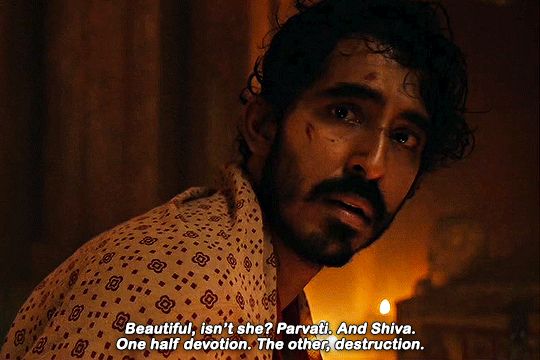

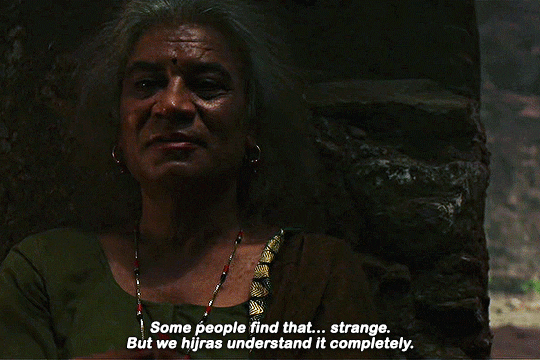


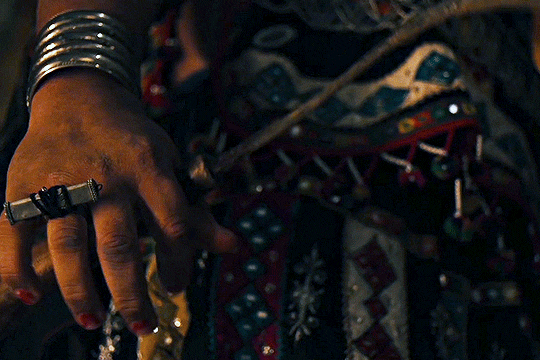


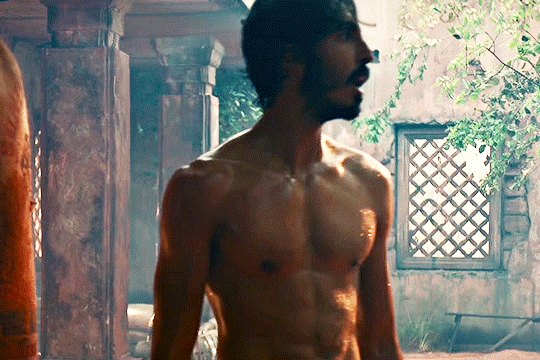

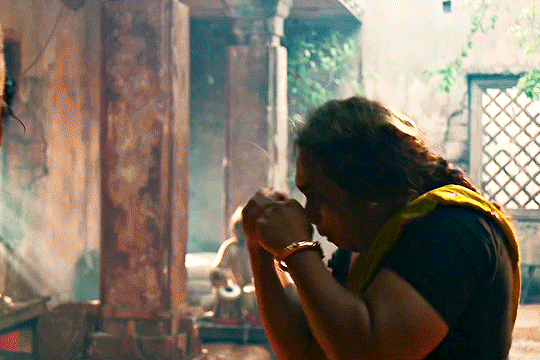


MONKEY MAN (2024)
#augh it was so good i couldn't stop thinking about it#and also i need to rewatch it because i kept getting distracted by dev patel's big beautiful eyes.....#does he have a licence for those#the mythology the politics the sectarian rife the hijra community and outsider he wove so many things together so beautifully#and also. he gave us an adorable dog. which is necessary to me.#and also he took his shirt off multiple times.#monkey man#dev patel#vipin sharma#spoilers#long post#transgender#lgbt#lgbtq#lgbtqia
20K notes
·
View notes
Text
Lets create a house where yelling means we’re having fun. When you hear a door slam you know it was accidentally pulled with too much strength, not slammed out of anger. When there is silence, it is Contentment, not another passive aggressive fight. The dog is no longer barking to protect, he simply just wants the cats to play with him. Let’s create a safe, warm environment that makes you feel like you can breathe, not hold your breath. Let’s stomp on the eggshells we use to tip toe on. Together we will make this house into a home. And welcome all with open arms into this kind and loving space.
#ftm t4t#t4t gay#lgbtqa#lgbt pride#lgbtq community#text post#mlm yearning#gay yearning#mlm love#trans mlm#mlm thoughts#mlm longing#gay thoughts#gayman#gay textpost#home & lifestyle#safe space#warm space#safe#queer#queer spaces#home#welcome home
28K notes
·
View notes
Text
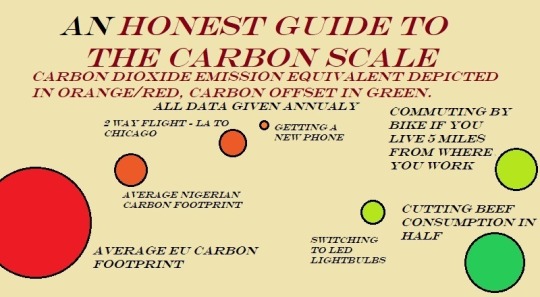















Sorry for the bad photo quality, Tumblr doesn't like posts this long.
#ramblings#politics#communism#socialism#climate change#not a reblog#when our turn comes#we shall not make excuses for the terror#environment#enviromentalism#carbon emissions#carbon footprint#global warming#climate collapse#anti capitalism#radical left#left wing#long posts#long post#color of the sky#hot take#this took like 20 minutes to upload because Tumblr kept crashing#and like 90 minutes to make
43K notes
·
View notes
Text
lived my whole life in guilt bc i thought i was responsible for people's feelings. newly realizing that other people are responsible for their feelings and reactions, even if they make it seem like i'm the problem. a lot of the time it really has to do w them and their own emotional regulation. i can't keep thinking i'm not allowed to have space bc of other people's insecurities. like i literally refuse to dim myself. other people are responsible for their feelings just as i'm responsible for mine.
#like i'm always gonna operate from a place of kindness but i've had to deal w so many people who're bad at communication/confrontation#which led me to think i'm the problem#that i deserve to be given the silent treatment or dismissed disregarded belittled etc#that's j not true. i'm far from perfect but i think so few people deserve that kind of reaction. and my biggest revelation is i do not#even if people want to make me think i do / that their reaction is justified / that i'm a burden etc#my biggest problem is i humor people like this for too long bc it's been normalized behavior to me#does this make any sense to anyone. it's the end of the year and i'm reflecting on so many things#p
11K notes
·
View notes
Text
It’s solar and wind and tidal and geothermal and hydropower.
It’s plant-based diets and regenerative livestock farming and insect protein and lab-grown meat.
It’s electric cars and reliable public transit and decreasing how far and how often we travel.
It’s growing your own vegetables and community gardens and vertical farms and supporting local producers.
It’s rewilding the countryside and greening cities.
It’s getting people active and improving disabled access.
It’s making your own clothes and buying or swapping sustainable stuff with your neighbours.
It’s the right to repair and reducing consumption in the first place.
It’s greater land rights for the commons and indigenous peoples and creating protected areas.
It’s radical, drastic change and community consensus.
It’s labour rights and less work.
It’s science and arts.
It’s theoretical academic thought and concrete practical action.
It’s signing petitions and campaigning and protesting and civil disobedience.
It’s sailboats and zeppelins.
It’s the speculative and the possible.
It’s raising living standards and curbing consumerism.
It’s global and local.
It’s me and you.
Climate solutions look different for everyone, and we all have something to offer.
#solarpunk#hopepunk#tidalpunk#cottagepunk#bright future#climate justice#environmentalism#optimism#social justice#community#solutions#pluralism#I know stuff like EVs and vertical farms get a bad rep#they are certainly overhyped and slight techbro solutions#but I think all avenues are worth exploring even if inevitably some will be less efficacious and just than others#sorry for the long tags lol
36K notes
·
View notes
Text
I've been seeing a lot of Discourse around outdoor cats that talks past one of the biggest problems addressing community cats/outdoor working cats so I thought I'd chime in with my two cents.
Many arguments I see just... don't think about the cats at all? Or don't consider the logistics of actually addressing the feral cat problem in a humane way. It's always about how outdoor cats shouldn't be outdoors, which is neither realistic nor helpful.
I used to volunteer at an municipal animal shelter in the USA that had a TNR program (Trap, Neuter, Return) and also adopted out community cats to local farms and businesses. Here's my side of the story.
"Your cat doesn't need to be outside" -- Yes, correct. Your domesticated (non-feral) house cat does not need to go outside at all. They can have a fully actualized life safely indoors. When I see this argument, proponents of indoor only cats are correct in most or all their arguments regarding this.
"Outdoor cats are the largest invasive species in the world, and decimate bird populations." -- This is also correct, and part of the reason why you can help by bringing your house cat indoors. Cats are the largest invasive species. Spay and Neuter your cats, bring them inside, and socialize them so they don't become feral.
"TNR doesn't work." -- False. Whether we like it or not, feral cats exist. We have two methods by which we can address the feral cat population -- decimating them (humanely euthanizing the whole colony) or TNR. For a long time, euthanasia was the preferred way to address the feral cat problem. Afterall, if the cats aren't there, doesn't that save the local wildlife population?
Except that we found, studying these colonies, that when a colony is wiped out, the cats of another colony will spread into their territory and continue to have kittens and the population of feral cats is neither controlled nor diminished.
Hence, TNR. What we found performing TNR on cat colonies was that this controlled the population of the colonies, allowing them to stay in their territory, which kept other colonies from spreading (especially colonies we hadn't performed TNR on yet). We at the shelter felt this was the most humane way to control the feral cat population and safely deflate their existence without dealing with the population blooms that euthanasia caused.
"What about kittens?" -- Kittens from these colonies were brought into the shelter, socialized, and fostered out until they could be adopted. Some of these semi-feral kittens needed special homes to be adopted into, but this was the best quality of life for these cats.
"What about cats that get missed during TNR?" -- We would return to the colony several times over a period of several years to perform TNR on the same colony. We mark cats that have been neutered by clipping their ear (this is done humanely, but is the most reliable way to tell if a cat has been neutered so the poor thing doesn't have to have surgery 3-4 times in their life). Also, during the TNR process the cats would be vaccinated to ensure disease did not spread from the colony (i.e. rabies). Still, even getting 60% of the colony TNR'd would dramatically reduce the number of kittens being added to the colony each year. This controlled the population by allowing the territory to naturally deflate in size over time, buying us time to address the larger feral cat problem.
"What if the colony was in an unsafe location?" -- There were two ways we addressed unsafe colony locations -- remember, we know that when the colony is removed, a new colony will move into its place, so we tried not to move the colony unless we really felt the cats or the public was unsafe -- one was to move the whole colony to a new location. Preferably someplace like a warehouse where we have an agreement with the owners of the warehouse. Some of the cats were even relocated to shelter grounds as our community cats. If the colony was small enough we would bring them into our Feral Cats room and adopt them out as community cats.
"What is a community cat?" -- The way the program worked, was that anyone who needed a working cat could apply to the program. These were often rural farmers or businesses with warehouses that needed rodent protection. We trained the farmers and businesses on how to acclimatize the cats to their new home, and as part of the agreement, they had to care for the cats (veterinary care, vaccinations, food and water). This gave businesses and farms an alternative to expensive and environmentally unfriendly rodent control, and also gave these feral cats good places to live out their natural lives.
"Can't you just adopt out feral cats?" -- No. Cats that have not been socialized around humans as kittens, or who have several generations of feral cat in them could not interact with humans in a way that did not cause them undue stress. This was not a humane way to handle feral cats. However, when a cat was brought into the feral cat room, they would be monitored for up to a week. If the cat displayed signs of being semi-social or fully social (hanging out outside of their den, allowing staff to pet them, showing interest in staff in the room), then we would either move the cat into the adoption room or place them in foster to be socialized before adoption. Feral cats who displayed signs of being able to live full and healthy lives with human companions were NOT adopted out as community cats. We also observed this behavior during TNRs and would do the same for those cats too.
"But aren't cats bad hunters?" -- Compared to other species, cats are not the most effective form of rodent control. This is true. However, you have to understand that feral cats exist. There is no "undo" button we can push to stop them from existing. We have to deal with the problem we have right now, which is to safely and humanely decrease the number of feral cats in our communities. And yes, we do that by using cats as rodent control in the community.
"What can I do?" -- Stop saying community cats shouldn't exist. That's not helpful and doesn't solve the problem we have. Bring your cat indoors. Spay and neuter your cats. Adopt from shelters. Volunteer with a TNR team. Support TNR efforts in your community. Recognize that those of us actively dealing with the community/feral problem are trying to do what is in the best interest of our communities and the animals we love. We aren't sitting over here saying these cats should exist -- a feral cat will not have the same quality of life as one that is indoors with a family -- but we have to address the problem in practical terms. We don't have the moral high ground to just do nothing while pontificating solutions that have no basis in actuality.
And yes, it's okay to celebrate community cats. If your local farm has a couple of working cats, that means that farm is helping participate in the safe deflation of the feral cat population. Don't shame a farm or business for using community cats. We're all doing the best we can to solve the problem that we have.
6K notes
·
View notes
Text

Hiii im Elle 👋😻
If you want to see more of me, check out my onlyfans - I post daily and answer every message ☺️💕
Tell me you're from Tumblr and get a freebie 💛
#18+ only#adult model#altgirl#big eyes#big tiddy committee#big tiddy community#big tiddy gf#br33dable#brown eyes#contentcreator#curvy body#fat tiddies#girls with tattoos#juicy body#long hair#natural bewbs#spicy links#spicy content#tattoos#ellefoxxx
6K notes
·
View notes
Text
I’m actually serious about this, if at all possible, right now is a very good time to request queer books from your local library. Whether they get them or not is not in your control, but it is so important to show that there is a desire for queer books. I will also say getting more queer books in libraries and supporting queer authors are pretty fantastic byproducts of any action.
This isn’t something everyone can do, but please do see if you are one of the people who has the privilege to engage in this form of activism, and if you are, leverage that privilege for all you’re worth.
For anyone who can’t think of a queer book to request, here is a little list of some queer books that I think are underrated and might not be in circulation even at larger libraries:
Refusing Compulsory Sexuality: A Black Asexual Lens on Our Sex-Obsessed Culture by Sherronda J. Brown
Silver Under Nightfall by Rin Chupeco
Harvard's Secret Court: The Savage 1920 Purge of Campus Homosexuals by William Wright
The Perks of Loving a Wallflower by Erica Ridley
God Themselves by Jae Nichelle
IRL by Tommy Pico
The Pink Line: Journeys Across the World's Queer Frontiers by Mark Gevisser
Passing Strange by Ellen Klages
The New Queer Conscience by Adam Eli
Fierce Femmes and Notorious Liars: A Dangerous Trans Girl's Confabulous Memoir by Kai Cheng Thom
Queering the Tarot by Cassandra Snow
Wash Day Diaries by Jamila Rowser
Queer Magic: Lgbt+ Spirituality and Culture from Around the World by Tomás Prower
Before We Were Trans: A New History of Gender by Kit Heyam
Beyond the Pale by Elana Dykewomon
Hi Honey, I'm Homo! by Matt Baume
The Deep by Rivers Solomon
Homie: Poems by Danez Smith
The Secret Life of Church Ladies by Deesha Philyaw
The Companion by E.E. Ottoman
Kapaemahu by Dean Hamer, Joe Wilson, Hinaleimoana Wong-Kalu
Sacrament of Bodies by Romeo Oriogun
Witching Moon by Poppy Woods
Tell Me I'm Worthless by Alison Rumfitt
Dead Collections by Isaac Fellman
Disintegrate/Dissociate by Arielle Twist
Dear Senthuran: A Black Spirit Memoir by Akwaeke Emezi
Peaches and Honey by Imogen Markwell-Tweed
Nepantla: An Anthology Dedicated to Queer Poets of Color by Christopher Soto
#queer books#queer history#lgbt history#honestly#libraries are a massive resource in terms of preserving and uplifting marginalized narratives#and as a community#that has been so very excluded from both fictional and nonfictional narratives#this is a great way to reclaim and care for the stories that have been surpressed for so long
11K notes
·
View notes
Text
sad: falling out of a hyperfixation
tragic: watching your beloved friends and mutuals fall out of the hyperfixation while you're still in it
#oughhhhhhh#this is about the dca fandom but also about every other strong fixation ive had over the years lol#i know it's normal and inevitable esp for less popular works or minor characters with little canon content#and there's nothing wrong with smaller communities of course those rock#but there’s just something special about getting into something at the same time as a lot of other people all at once#and existing in this chaotic fandom space that's just bursting with creativity and passion#i've been in fandom spaces for as long as some of you have been alive and i've only come across that sort of unbridled joy like#a handful of times at best#it's just a heartbreaking feeling to see real lightning in a jar fandoms like that wither away as people drift away#(understandably so!)#anyway don't mind me i'm just having thoughts#musing about fandoms past as well#that i too eventually moved on from but remember fondly even if im not active in anymore#also my music just aint hitting right so im just sitting in silence which makes me more Contemplative(tm)
7K notes
·
View notes
Text
cuz I can i'm gonna make a hyperspecific queer shout out post bc I want to appreciate all the lovely people in my life and more
shout out to men who used to be lesbians and women who used to be gay
shout out to fem bigenders
shout out to nonbinary people who don't like they/them pronouns
shout out to feminine men whose shoe collection is 90% heels & platforms
shout out to gender fluid folks who make really, really bad puns
shout out to the fem he/theys & the masc she/theys
shout out to the people who collect pronouns like a rock collection
shout out to literally every aromantic person ever
shout out to the trans drag queens & drag kings
shout out to all the gays obsessed with baldurs gate 3
shout out to the angriest and most passionate scenemo trans guy you'll ever meet in your life
shout out to the agender folks who make *gives you my gender* jokes
shout out to the most gender looking guy you'll ever meet
and shout out to you, queer person reading this. I love you
#thoughts by shark#long post#friends#transgender#lgbtq#lgbtqia#lgbtq community#lgbtqia positivity#queer community#nonbinary#aromantic#bigender#multigender#drag king#drag queen#queer#lesbian#gay#genderfluid
3K notes
·
View notes
Text
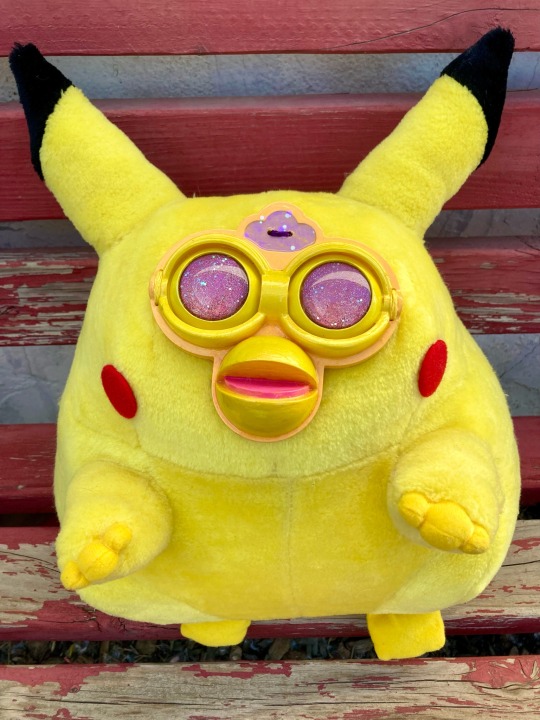
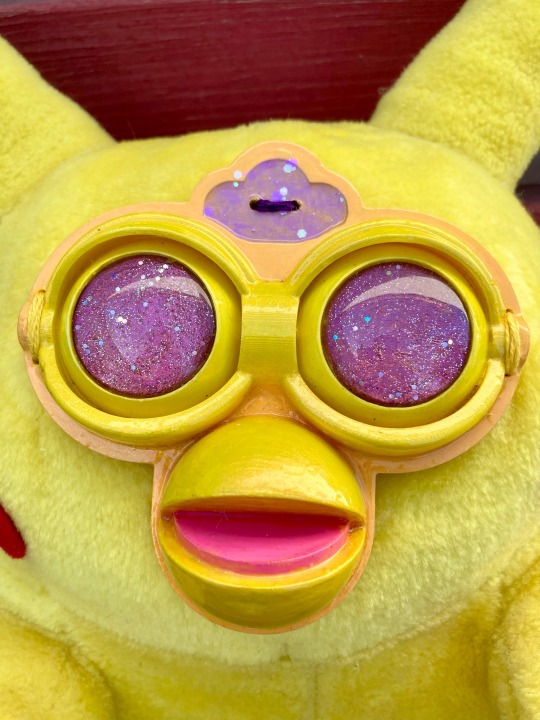
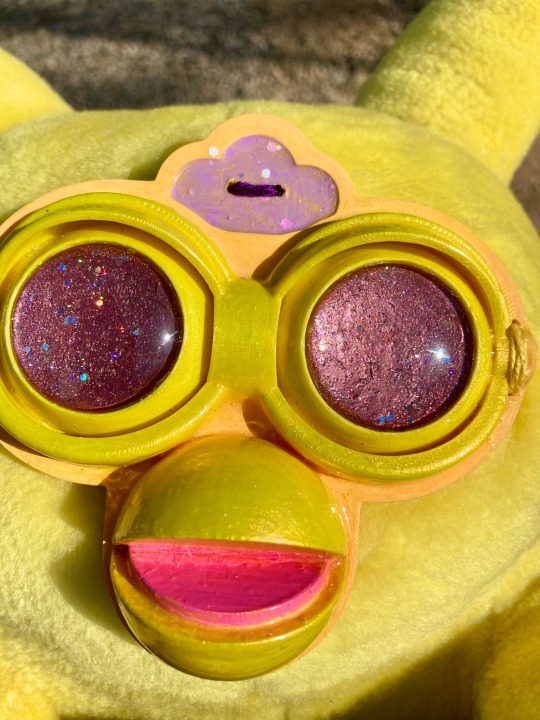
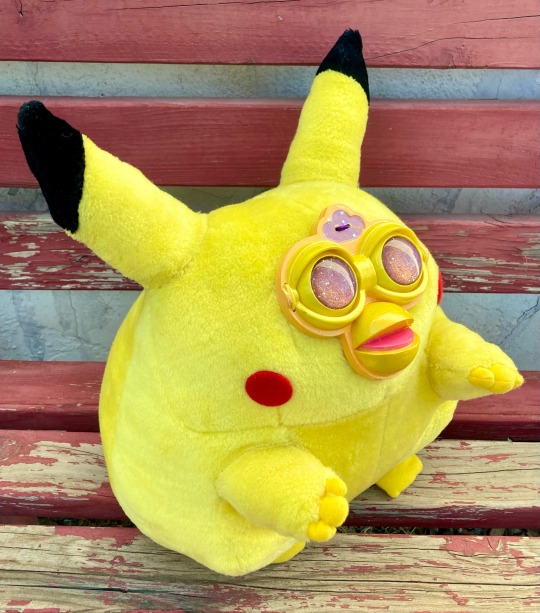



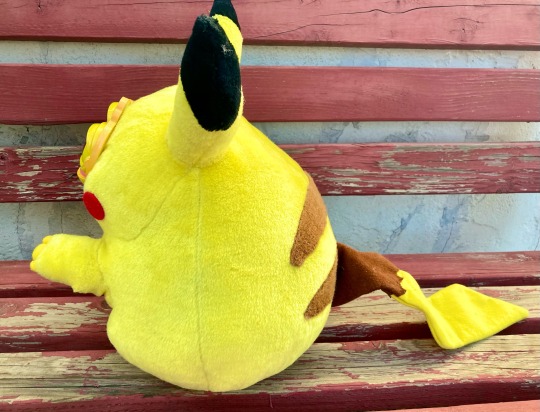

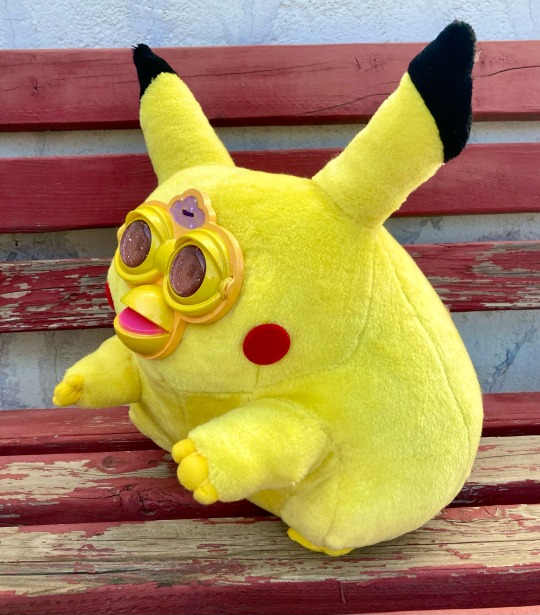
Introducing a one-of-a-kind Pikachu Furby that is perfect for any collector or fan of the popular video game Pokemon franchise or Furby. This handmade creation boasts a 3D printed Furby face plate that adds a unique and kawaii touch to its appearance. With its bright yellow fur and it’s disturbing looks, it is sure to grab attention and become a conversation piece. He will give onlookers a warped sense of nostalgia. Pikachu Furby will live rent free in the minds of people. Reminding them that so much time has passed and trying to hold onto childhood memories.
Made in the United States, the Pikachu Furby is the perfect addition to any toy or nightmare fuel collector. Its unique character family - Pikachu/Furby - brings a level of uneasiness to this plush pet that is sure to send shivers through children and adults alike.
https://www.mercari.com/u/528326732/
#handmade#kawaii#ooak#rainbow#handmade plush#furby fandom#furby community#long furby#furby#pokemon#fat pikachu#pikachu#nightmare fuel#creepy#videogame#1990s#nostalgia
3K notes
·
View notes
Text
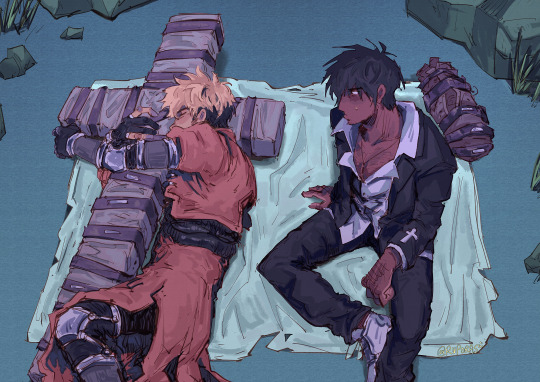

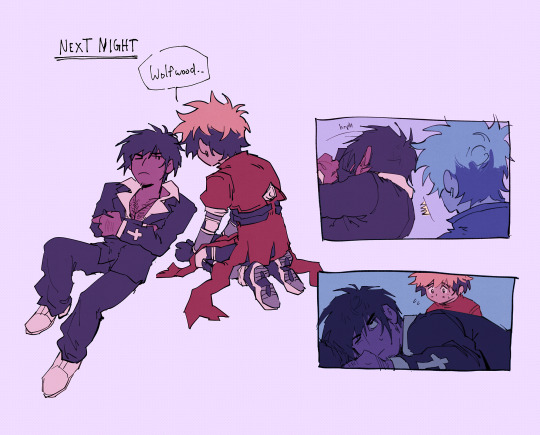
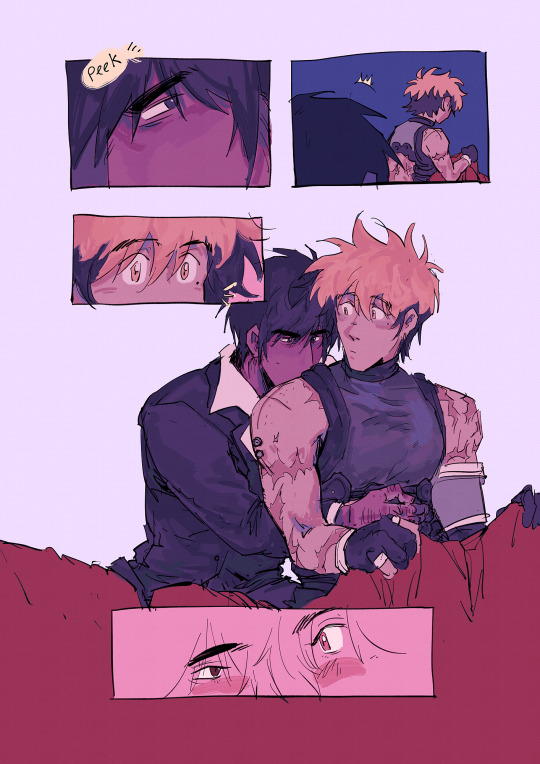

being a little petty (ID in alt)
#vashwood#vash the stampede#nicholas d wolfwood#trigun#trigun maximum#petty vash moment - i think he deserves the chance to be petty... and he's kind of a petty person to me in some circumstances mfgksmgk#DEFINITELY to wolfwood i'd imagine... because they're petty to each other in exchange for not speaking about their Feelings or sorting#things out verbally. it's just how they communicate. not outlandish fights - or ignoring each other completely - but just little petty ways#that ends up getting solved anyway. i imagine it always tends to be wolfwood who “solves” it while vash doesn't necessarily “solve” it#he just ignores it? or accepts it as is? like broods for a day maybe in unnoticeable to anyone but ww kind of way but#returns to a normal attitude the next day while ww is like ??? fuck this guy - before ultimately just accepting it as is because he doesn't#/want/ to be mad at vash. i also dont think ww is someone who can be mad for super long... unlike vash who's had anger for like 150 years#ruporas art
4K notes
·
View notes
Text

HUGE congrats to sir Skizzleman for hitting that big shiny 100k!!!!
#skizzleman#fanart#hermitcraft#I’ve been waiting for this day for so long#ALSO SKIZZ IS A HERMIT YAYAYYY#I can’t get over how excited I am for him I’ve been hoping for this to happen for literal years#No more captioning things as hermits + Skizz! Lol#I can’t wait for him to get to know all the other hermits and really become a part of the community#I’m so happy ok that’s all :D
2K notes
·
View notes
Text

Hi lovelies 😊🥰
#long-ana-conda#transgenresworld#trans is sexy#transisbeautiful#transfem#trans woman#trans pride#transgender#transgirl#lgbtq community#lgbtq#lgbt pride
1K notes
·
View notes
Text
Tips for writing and drawing Wheelchair using characters: Your character's wheelchair can tell us a lot about them
When you first start learning character design, you'll often be told something to the effect of "use your character's outfit to tell us more about them" - and this same principles can be applied to a disabled character's mobility aids.
Mobility aids like wheelchairs, to many disabled people, are a part of us. They can be an extension to a person's body and chances are, if you're going to be using this piece of equipment every day for the foreseeable future (or at least for a good amount of time for the foreseeable future), it's going to start reflecting some aspects of your personality, your interests, your passions, especially when you remember, a lot of people get their wheelchairs custom built for them.
You can use your character's wheelchair to tell us a lot about them without ever needing to show/describe them directly.
Let me show you two examples:

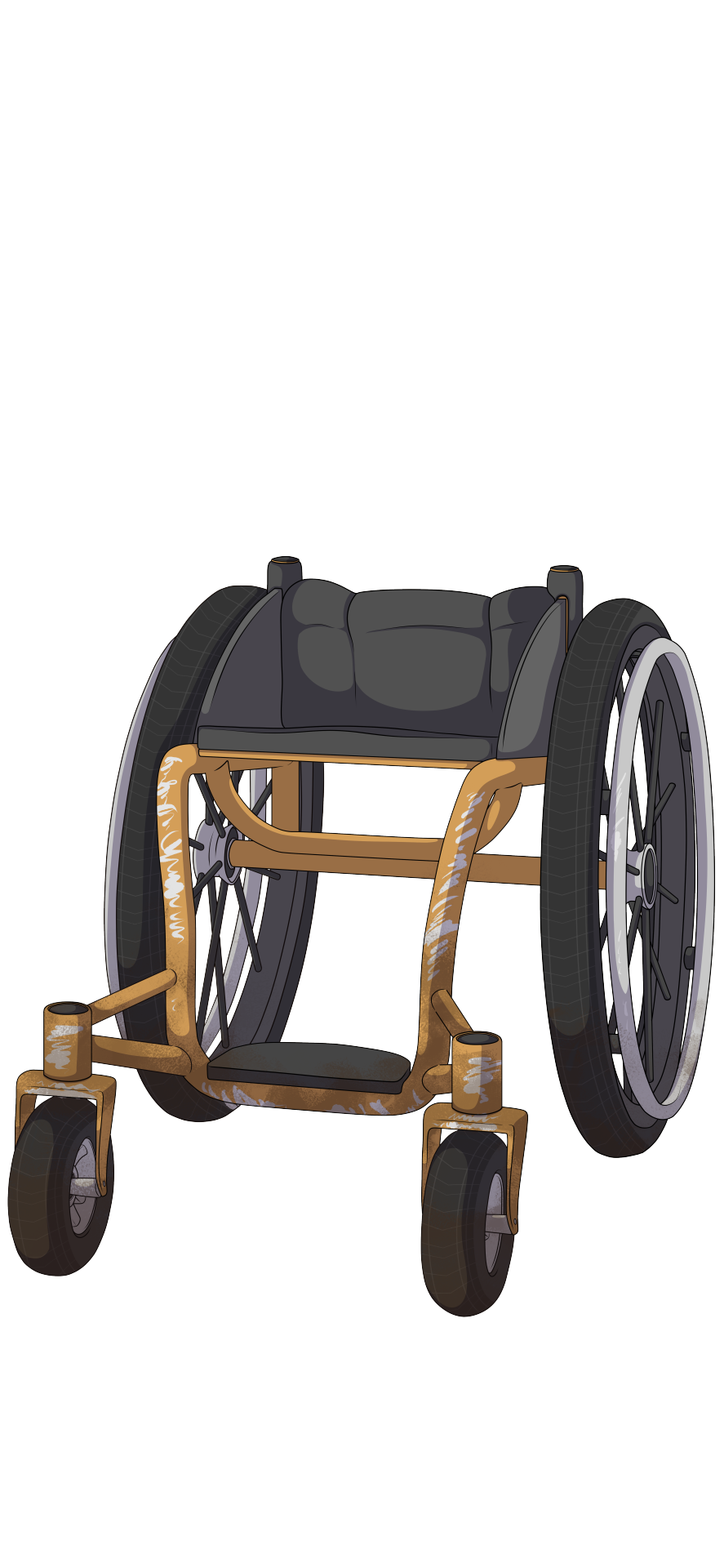
Take a look at these two wheelchairs. they're similar in shape and build, but still pretty different to each other. Can you make some guesses about their users based only on what's shown here?
intended answers below:
Please note, the following points are all generalisations and the real world is rarely this simple. This is to demonstrate how to use disability aids to contribute to your character's design, not how to make assumptions about real people in real life.
So here are some similarities between the chairs:
Both wheelchairs have ridged frames, this means the wheelchair can't be folded in any way. These kinds of chairs can imply a few different things depending on the person. They are typically lighter, sturdier and more durable, and indicate the person probably will be using the wheelchair for a long time and/or has the money to get something built to last (or lives in a place where cost not an issue due to universal/subsidised access to healthcare). They are also typically better to travel with when flying, as they are less likely to be broken by airport security/staff.
Both wheelchairs also lack anti-tip wheels, which are a third set of wheels that extend from the back of the chair. Them not being present could indicate the person is likely pretty confident in their ability to use the chair without worrying about tipping out. It could also indicate they are in an environment where the anti-tips could be more of a hazard than a help, such as on rough terrain.
So lets look at some specifics for the green wheelchair:
Take a look at the wheels. The front wheels are pretty small and appear to be solid, while the back wheels appear to be quite narrow (compared to the orange chair anyway). This indicates the user likely lives somewhere with decent accessibility like a (well funded) city where they are unlikely to encounter unpaved/dirt roads/grass. Small front wheels and thin back wheels are good for manoeuvrability and a smooth ride over even terrain, but they will get stuck as soon as bumps appear, so this probably isn't an issue for this person.
While its a bit hard to tell unless you have seen other similar wheelchairs, this wheelchair is very long in the front, meaning the footplate and front wheels are further away from the seat than most. There could be a few reasons for this. One either indicates the person has very long legs, or a lack of motion in their knees, making it harder to bend their legs. This is moves the chair's centre of gravity forward by a decent amount, making it harder to tip back, which could indicate the person's legs are very light. You tend to see this most often in the wheelchairs of bilateral leg amputees, who are at a greater risk of tipping backwards due to a lack of weight at the front of the chair (even if they wear their prosthetics).
The colour of the chair is bright. This could simply be the character's favourite colour, or maybe this colour has some significance to them?
There are stickers on the side of the chair relating to the Paralympics. This could indicate the person is a fan, or perhaps had some involvement in the games?
The wheelchair has handles on the back, but they are able to be folded down. This is a popular feature for people who are independent enough to go out on their own, but still want to have the option for some help. folding down the handles also deters random strangers from grabbing at you (an unfortunately common experience for wheelchair users).
There is some mild paint scratching to the front of the wheelchair, but nothing too noticable. This is typical of older chairs and people who are a little rough on their chairs. Maybe they've had a few stacks and falls throughout the years, probably going a decent speed.
Ok, now let's look at the orange chair
This wheelchair has very large, inflatable front wheels, and very thick back wheels. This will make the chair slower and less manoeuvrable on flat/even surfaces, but much, much easier to push on rough terrain. This is supported by the amount of mud on the wheelchair.
The seat on this wheelchair tilts upwards slightly. This is called a bucket (or according to an old basketball teammate of mine, a dump-truck lol). This is a feature you typically see in wheelchairs made for people with spinal injuries who are unable to move their legs and engage their lower bodies or core to help keep them stable.
The back of this chair is very low, indicating that if this wheelchair user has a spinal injury, it's probably pretty low on their spine, likely fairly close to the hips, making the person a low-level paraplegic. Higher-level paraplegics and quadriplegics usually need a higher back to help support them and keep them from flopping over, since all the muscles below their place where their spine broke either doesn't work, or is significantly weaker. Higher backs though can get in the way of pushing and reduce mobility, so people who need less support will likely opt for a lower back rest.
This wheelchair has no handles, which indicates the user is probably very independent and doesn't need a lot of help getting around.
The paint on this wheelchair is very scratched up, showing the person is very tough on their wheelchair and doesn't care to get the paint touched up.
This wheelchair has no breaks. This is very common on chairs with larger tiers as they don't tend to be as effective, but also on many outdoor wheelchairs, for two reasons. One is because they are made for rough terrain, so chances are, you aren't going to go far without a big push to get you moving. The second reason is that to get over large bumps and obsticals in a wheelchair, it can be helpful to do very large pushes using the top and front of the wheel. When pushing a normal chair, most people will only use the top section of the wheel to push since it's closest, but these big pushes that use the front of the wheel make it easier to push, since you can benefit from downwards momentum. However, this is also where the breaks are located on most wheelchairs, which can create a hazard. I've lost entire fingernails by them getting snagged on the breaks when pushing this way. So if you live somewhere where the breaks are not going to be helpful to you often, it makes sense to not get them.
And here are the characters who own these wheelchairs
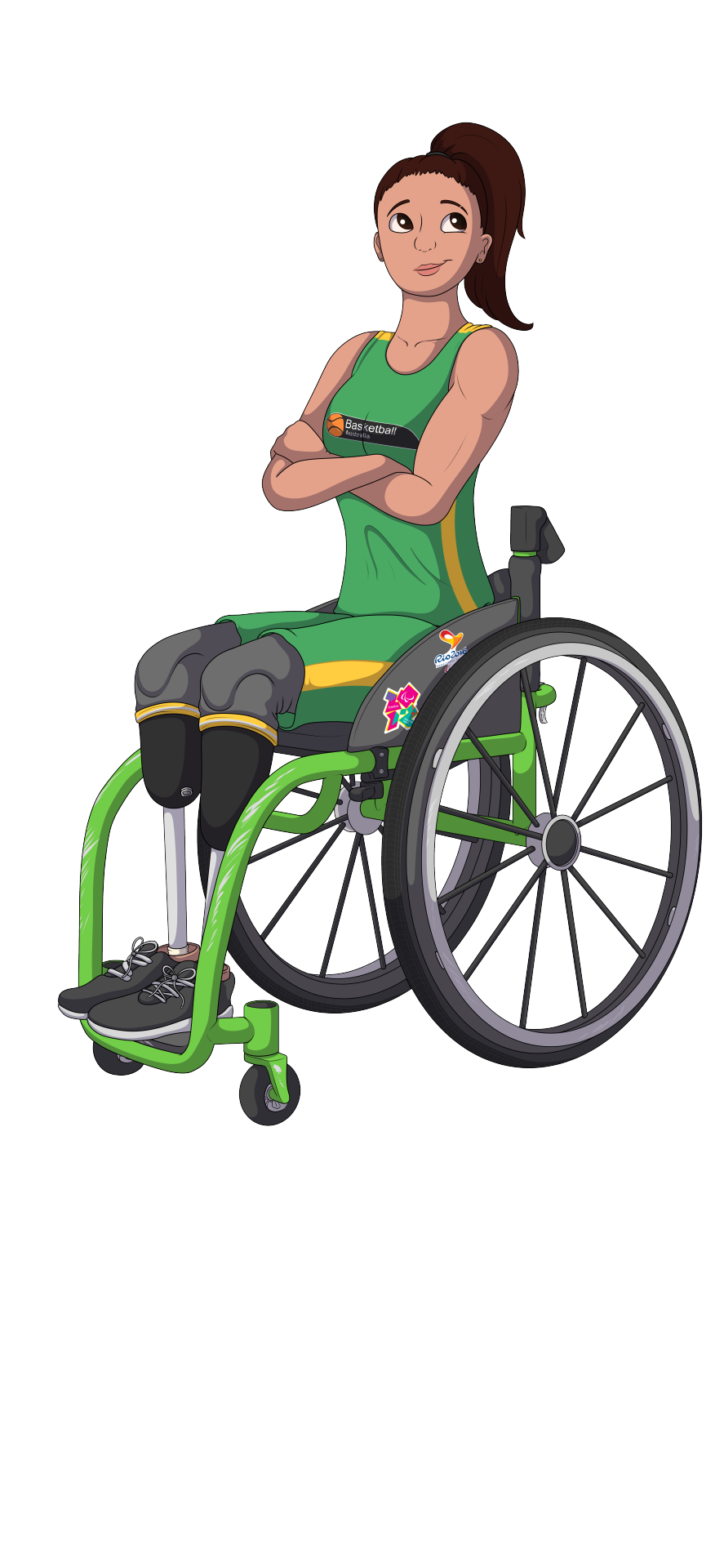
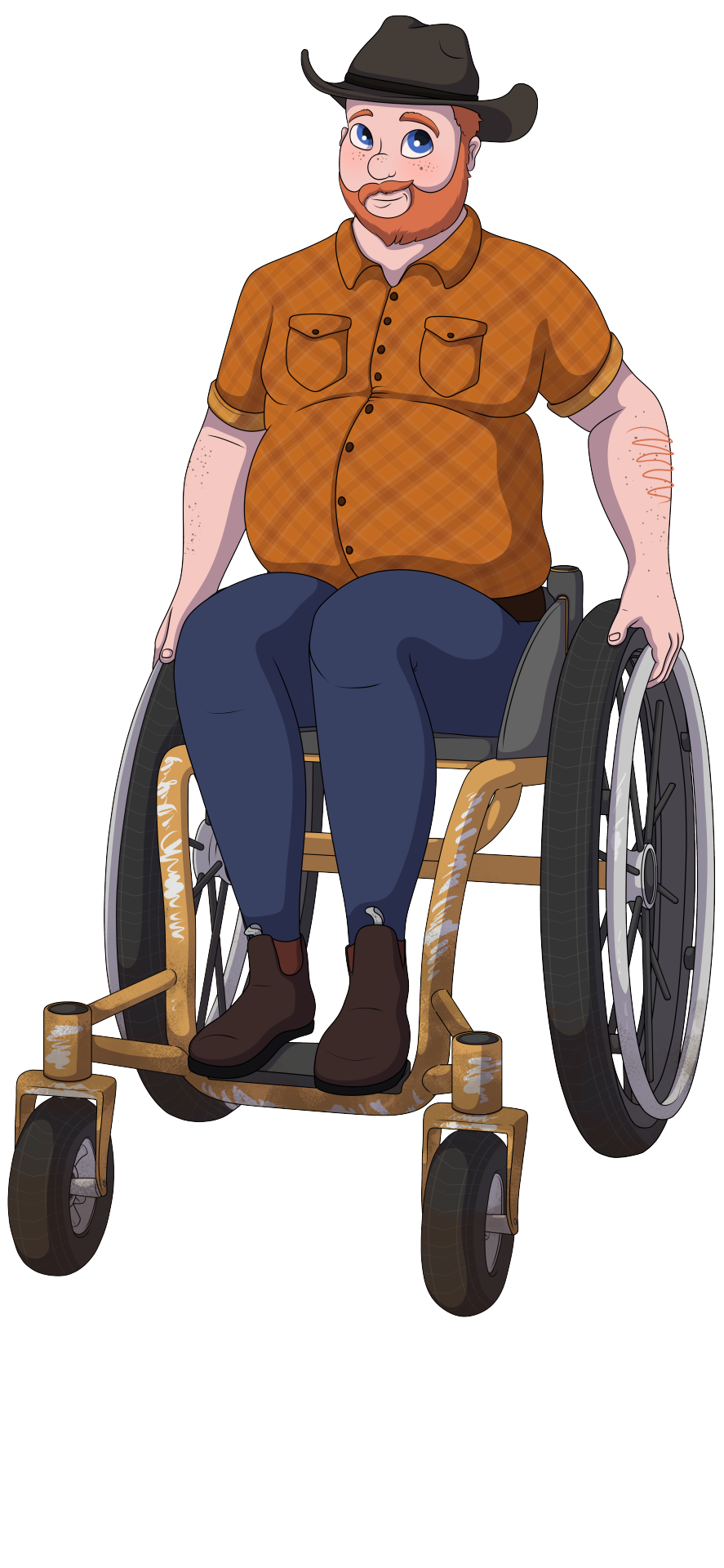
The owner of the green wheelchair is an amalgamation of a few people I knew from when I played wheelchair basketball. They're a bilateral leg amputee, and judging by their outfit (The Official National Wheelchair Basketball uniform for Australia), they're an elite athlete. This wheelchair is not the one they play sport in, but it still needs to be durable enough to withstand the rough treatment of airport staff when traveling, as well as heavy day-to-day use that comes with being an active person. While it needs to be rough, the person also seemed to want to prioritise speed and manoeuvrability, and likely doesn't need to worry about rough terrain too much, so they probably live in a major city.
The owner of the orange chair was inspired by a family friend of mine. They live on a farm, and need a chair that can handle life in those conditions, rough terrain and all. This comes at the cost of speed and manoeuvrability on smoother terrain, but honestly, anyone who's lived in the country knows you won't find many of those around there anyway, so that's not too big of a sacrifice. They are paraplegic, are very confident in their ability to use their wheelchair, and probably doesn't need help too often, but still benefit from some extra stability support from the raised seat on their chair.
Conclusion
Once again, these are generalisations, and in real life there are always exceptions, but I hope this helped demonstrate what I meant when I said you can use your character's wheelchair to tell us more info about them if you're smart about it.
I originally planned to do a whole series of these, showing a wider variety of wheelchairs and the people who they belong to, but I guess I kind of forgot because they've been sitting, abandoned on my hard drive for the last 2 years 😅. If that's something you folks would be interested in seeing though, let me know, I'd happily revive the series lol.
#Writing Disability with Cy Cyborg#id in alt text#long post#writing disability#disability#disabilities#disabled#physical disability#wheelchair user#physically disabled#wheelchair#character design#character illustration#character concept#Designing Disabled Characters#writers on tumblr#writing#writing community#writblr#writerblr#writing advice#writing tips#writing resources#art reference#artists on tumblr#artblr#illustrator#visibly disabled#disabled and proud
4K notes
·
View notes